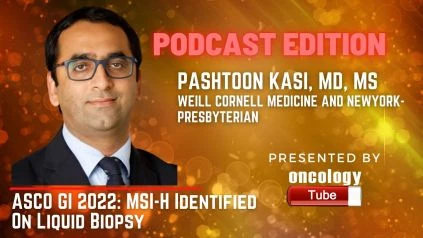Pashtoon Kasi, MD, MS, Director, Colon Cancer Research, Director, Liquid Biopsy Research, Sandra and Edward Meyer Cancer Center at Weill Cornell Medicine, Englander Institute of Precision MedicineClinical Assistant Professor of Internal Medicine – Hematology, Oncology and Blood and Marrow Transplantation from Weill Cornell Medicine and NewYork-Presbyterian Hospital. In this video, he speaks about the ASCO GI 2022 Abstract – Clinical utility of microsatellite instability (MSI-H) identified on liquid biopsy in advanced gastrointestinal cancers (aGI).
Â
Â
Origins:
Â
Given the approval of many immune checkpoint medications, finding MSI-H in patients with aGI is clinically significant. MSI-H has long been determined through tissue analysis, and information gained from plasma-based techniques has been limited to modest validation studies. The goal of this study was to determine the prevalence of MSI-H status in the aGI and to report real-world outcomes of colorectal (CRC) patients who received ICI following MSI-H detection using a commercially available liquid biopsy (LBx) assay.
Â
Methodologies:
Â
Genomic findings from a well-validated LBx test (Guardant360) performed as part of routine clinical care in patients with aGI between October 1, 2018 and July 7, 2021 were analyzed to determine MSI-H prevalence and identify cases of probable acquired MSI-H. The GuardantINFORM database, which contains aggregated payer claims and de-identified records from 11/1/2018 to 3/31/2021, was used to gather real-world evidence (RWE). Patients with MSI-H detected in plasma who began new therapy within 60 days after the assay report date were divided into two groups: chemotherapy plus biologic therapy (“chemo”) and immunotherapy with pembrolizumab or nivolumab (“ICI”). Progression-free survival was measured using real-world time to discontinuance (rwTTD) and real-world time to next treatment (rwTTNT). Differences in rwTTD, rwTTNT, and overall survival were assessed using log-rank testing.
Â
Findings:
Â
MSI-H was found to be present in 2% of aGI patients (Table). Five instances were found to have acquired MSI that was not due to tumor shed as determined by serial LBx testing. Within 60 days of receiving their results, 89 (40 percent) of the 222 MSI-H CRC patients who were eligible for RWE analysis began new therapy: 42 (48 percent) received ICI, 39 (44 percent) received chemo, and 8 (9%) received other/mixed regimens. ICI patients had significantly longer rwTTD and rwTTNT than chemo patients [median months to discontinuation = 7.5 (95 percent CI 3.4-12.3) vs. 2 (95 percent 1.4-3.3) p0.001; median months to next treatment = 23.8 (95 percent 10.6-NA) vs. 4.5 (95 percent CI 2.9-NA) p=0.006]; no overall survival difference was observed (p=0.559).
Â
Outcomes:
Â
This LBx test discovered MSI-H at similar frequencies to previously published tissue cohorts, suggesting that it could be used to detect acquired MSI-H after early lines of therapy. Patients who received ICI after LBx identified MSI-H had responses similar to those seen in previously treated aGI patients. Well-validated LBx is a viable technique for identifying initial and acquired MSI-H in aGI, and it may increase the number of patients who can benefit from ICI therapy, especially in cases when tissue specimens are unavailable.

